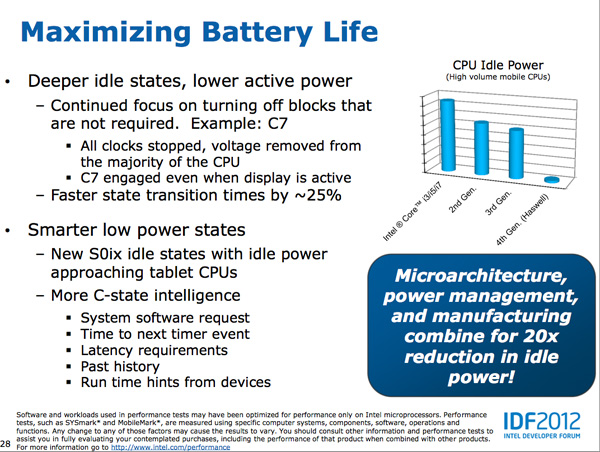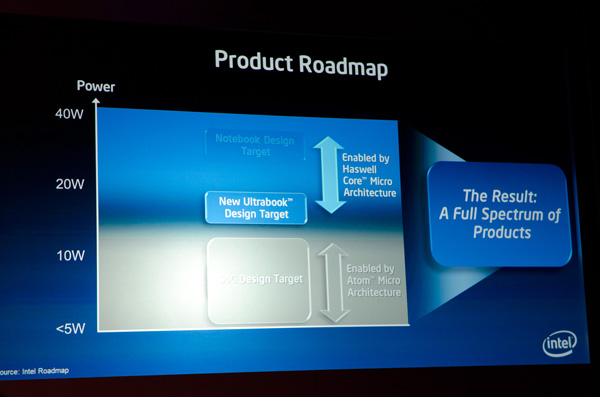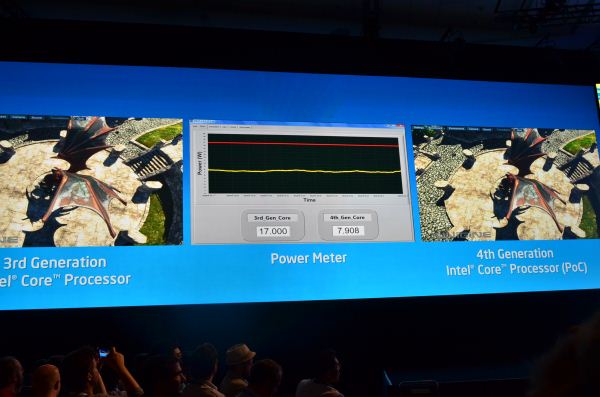Intel's Haswell Architecture Analyzed: Building a New PC and a New Intel
by Anand Lal Shimpi on October 5, 2012 2:45 AM ESTOther Power Savings
Haswell's power savings come from three sources, all of which are equally important. We already went over the most unique: Intel's focus on reducing total platform power consumption by paying attention to everything else on the motherboard (third party controllers, voltage regulation, etc...). The other two sources of power savings are more traditional, but still very significant.

At the micro-architecture level Intel added more power gating and low power modes to Haswell. The additional power gating gives the power control unit (PCU) more fine grained control over shutting off parts of the core that aren't used. Intel published a relatively meaningless graph showing idle power for standard voltage mobile Haswell compared to the previous three generations of Core processors.
Haswell can also transition between power states approximately 25% faster than Ivy Bridge, which lets the PCU be a bit more aggressive in which power state it selects since the penalty of coming out of it is appreciably lower. It's important to put the timing of all of this in perspective. Putting the CPU cores to sleep and removing voltage/power from them even for a matter of milliseconds adds up to the sort of savings necessary to really enable the sort of always-on, always-connected behavior Haswell based systems are expected to deliver.
Intel has also done a lot of work at the process level to bring Haswell's power consumption down. As a tock, Haswell is the second micro-architecture to use Intel's new 22nm tri-gate transistors. The learnings from Ivy Bridge are thus all poured into Haswell. Intel wasn't too specific on what it did on the manufacturing side to help drive power down in Haswell other than to say that a non-insignificant amount of work came from the fabs.
The Fourth Haswell
At Computex Intel's Mooly Eden showed off this slide that positioned Haswell as a 15-20W part, while Atom based SoCs would scale up to 10W and perhaps beyond:
Just before this year's IDF Intel claimed that Haswell ULT would start at 10W, down from 17W in Sandy/Ivy Bridge. Finally, at IDF Intel showed a demo of Haswell running the Unigen Heaven benchmark at under 8W:
The chain of events tells us two things: 1) Intel likes to play its cards close to its chest, and 2) the sub-10W space won't be serviced by Atom exclusively.
Intel said Haswell can scale below 10W, but it didn't provide a lower bound. It's too much to assume Haswell would go into a phone, but once you get to the 8W point and look south you open yourself up to fitting into things the size of a third generation iPad. Move to 14nm, 10nm and beyond then it becomes more feasible that you could fit this class of architecture into something even more portable.
Intel is being very tight lipped about the fourth client Haswell (remember the first three were desktop, mobile and ultra-low-volt/Ultrabook) but it's clear that it has real aspirations to use it in a space traditionally reserved for ARM or Atom SoCs.
One of the first things I ever heard about Haswell was that it was Intel's solution to the ARM problem. I don't believe a 10W notebook is going to do anything to the ARM problem, but a sub-8W Haswell in an iPad 3 form factor could be very compelling. Haswell won't be fanless, but Broadwell (14nm) could be. And that could be a real solution to the ARM problem, at least outside of a phone.
As I said before, I don't see Haswell making it into a phone but that's not to say a future derivative on a lower power process wouldn't.













245 Comments
View All Comments
Spunjji - Thursday, October 18, 2012 - link
Fuckwit.nirmalv - Sunday, October 7, 2012 - link
Anandtech being a hardware site,its more inclined to keenly flow hardware devices with new architecture and innovations. iphone brings in1, A new A7 chip design and a novel 3 core graphics core
2, A new 3 microphone parabolic sound receiving design(which likely will become the new standard)
3, A new sim tray design(which will also likely become the new standard)
4, New sony BSI stacked sensor (the 13 mpx version will likely be the rage next year).
5, The first time that we have a 32 nm LTE chip which will give all day usage.
6, New thinner screen with incorporated touch panel and 100 % RGB
I am not sure about samsung but can anyone enlighten me about S3's technical achievements?
nirmalv - Sunday, October 7, 2012 - link
Sorry make that a 28 nm LTE basebandcenthar - Sunday, October 7, 2012 - link
99.998% of iPhone users just don't care about that. Really they don't.Geeks like me who do, are too damn smart to sell our souls to the such a god damned, locked down and closed system to even bother to care.
Magik_Breezy - Sunday, October 14, 2012 - link
2nd thatSpunjji - Thursday, October 18, 2012 - link
3rdCaptainDoug - Tuesday, October 23, 2012 - link
4th,solipsism - Tuesday, October 9, 2012 - link
Of course a company that releases one device per product category per year as well as one with the greatest mindshare is going to have more articles.But what happens when you add up all Samsung phones against all Apple phones in a given year?
What happens when you don't count the small blogs that only detail a small aspect of a secretive product but count the total words to get a better feel for the effort spent per company's market segment?
I bet you'll find that AT spends a lot more time covering Samsung's phones than Apple's.
Spunjji - Thursday, October 18, 2012 - link
This. I generally trust their editorial, but the focus on Apple prevails. One just has to read accordingly.Kepe - Friday, October 5, 2012 - link
Also look at any other Apple product review. They are all ridiculously in-depth with analysis about almost every single component in the product. Macbook Pro with Retina Display got 18 pages, the 3rd gen iPad got 21 pages. Don't get me wrong, I like a proper review with everything analyzed, but it's only the Apple products that get these huge reviews. But compared to those massive Apple reviews, it's like all other products are just glanced over in a hurry. The new Razer Blade got 9 pages. Asus Transformer Pad Infinity got 8 pages.